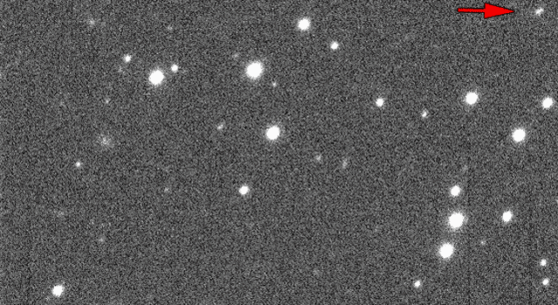NASA estimates that they have discovered 90% of near-Earth objects that are more than one kilometer in diameter - which could cause mass extinctions

Over 10,000 asteroids and comets that may pass near the Earth have been discovered so far. The ten-thousandth object - the asteroid 2013 MZ5 was first discovered on the night of June 18, 2013 by the PanSTARRS-1 telescope of the PanSTARRS project located on the summit of the Haleikala volcano on the island of Maui and managed by the University of Hawaii. The Panstars survey was funded by NASA.
"The discovery of 10,000 near-Earth objects is an important milestone," says Lynaldi Johnson, senior director of NASA's Near-Earth Object Observation (NEOO) program at NASA Headquarters in Washington. "However, there are at least 10 times more objects that still need to be found before we can guarantee that we have discovered every object that could collide with us and cause significant damage to the inhabitants of the planet."
Near-Earth objects are asteroids and comets that may reach a distance of up to 45 million kilometers from the Earth's orbit around the Sun. Their size ranges from small rocks with a diameter of a few meters to a diameter of 40 kilometers - the diameter of the best-known near-Earth object - the asteroid Ganymede (1036). 98% of all known near-Earth objects were discovered by survey systems supported by NASA.
Asteroid 2013 MZ5 is about 300 meters in diameter, its orbit is well known and it will not get close enough to cause potential danger in the foreseeable future. "The first object from which the count began, was discovered in 1898," says Don Yeomans, director of the Office of Near-Earth Objects at NASA's Jet Propulsion Laboratory (JPL) in California. During the following hundred years, only about 500 more objects were discovered, but since then, thanks to the NASA NEOO observation program founded in 1998, we began to discover them in large quantities. Now that more sophisticated systems are about to come into play, we are learning even more about near-Earth objects.
Of the ten thousand objects discovered, about 10% are larger than a kilometer in diameter - roughly the size that could cause damage on a global scale if they hit the Earth. However, NASA's NEOO program discovered that none of these objects are on a possible collision course with Earth, and it is estimated that only a few objects of this size have yet been discovered.
"The vast majority of these objects are smaller than a kilometer, and of course their number is increasing as their size decreases, for example, it is estimated that there are about 15 objects with a diameter of up to 150 meters, and over a million objects with a diameter of 30 meters. 30 meters is the minimum size of an object that could cause significant damage if it falls in a populated area. Only about 30% of the objects with a diameter of 150 meters were discovered, but only 1% of the objects with a diameter of about 30 meters were discovered.
When the program was founded, it provided support for search programs of the Lincoln Laboratory at MIT known as LINEAR, for the NEAT program of JPL, for the programs of the University of Arizona (Spacewatch and later - the sky scanner Catalina), and the Wall Observatory (LONEOS). The central place where all these observations are concentrated and coordinated is the center for small objects in the solar system of NASA and they are given unique names, as well as they are tracked for an accurate calculation of their orbit.

"When I started looking for asteroids and comets in 1992, the discovery of a near-Earth object was a rare event," says Tim Spahr, director of the Center for Small Objects in the Solar System. "Today, a new near-Earth object is discovered every day on average, and every month my office coordinates hundreds of thousands of observations of asteroids, including those in the central asteroid belt. The work in the surveys funded by NASA is done by professional and amateur astronomers from all over the world. Discovery and tracking of near-Earth objects is done in a particularly impressive way."
"Within a dozen years, the program achieved its goal - they discovered 90% of near-Earth objects with a diameter of over a kilometer. In December 2005, NASA received a directive from Congress to locate, discover and catalog 90% of near-Earth objects with a diameter of 500 meters or more. When this goal is achieved, the risk of future damage to the Earth will be reduced to a level of XNUMX percent compared to the risk that existed before the surveys began. This will reduce the risk of harm to humans because as soon as the threat of a near-Earth object is detected long enough in advance, it will be possible to repel it with current space technologies.
Currently, the main bodies involved in detecting near-Earth objects are the Catalina Sky Scanner, the University of Hawaii's FanStars Survey, and MIT's Linar. The current rate of discovery is about a thousand near-Earth objects per year.
For information on the NASA website

3 תגובות
A. from the space tourism office,
What happens to the tickets I ordered for a weekend in Mars?
I am not answered in your office!
Benjamin, let me correct you
The asteroid does not have to directly hit humans for there to be a mass extinction.
It's enough for the ecology system to be damaged and us, it's only a matter of time.
See the example of the dinosaurs (not all of them died at the moment of impact)
When calculating the risk of being hurt, you have to remember that most of the Earth's surface is not
Inhabited by humans, i.e. only an object that can cause global damage
Necessarily dangerous for humans, we'll manage with everything else...